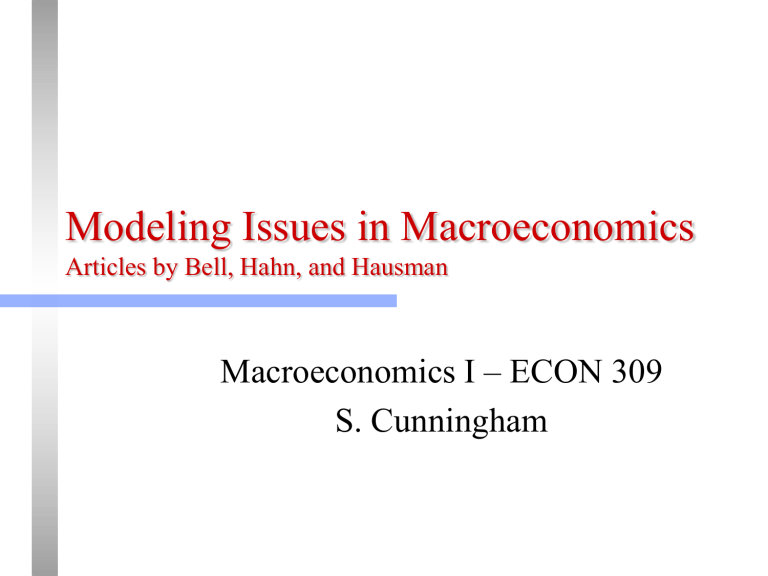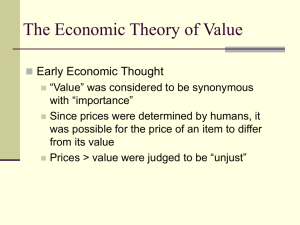Modeling Issues in Macroeconomics Articles by Bell and Hahn
advertisement

Modeling Issues in Macroeconomics Articles by Bell, Hahn, and Hausman Macroeconomics I – ECON 309 S. Cunningham Models and Reality Under liberalism, human beings are regarded as individuals detached from family, clan, class, or nation, as independent, self-determining beings. This leads to methodological individualism. If we regard the economic system as an enormous composition of independent, specialized agents, then the central problem of economic inquiry is the explanation of the exchange process. If the exchange is made through free markets, then the explanation of exchange is coincident with the explanation of prices. Note: the market process does not require that all people be selfish, but rather that they have a self-interest and act purposefully. 2 Models and Reality (Continued) Marginalists. The neoclassicals make relative prices and relative scarcity the fulcrums of economic analysis. – – – – – – Methodological individualism Focus on the margin Diminishing marginal utility Price theory vs. value theory: the measure of something is its utility, not its value General Equilibrium Utility maximization “The individual is imagined in a constant process of delicately balancing his marginal expenditures and marginal utilities.” – here we have the idea of the “economic man”, a term introduced by Pareto. 3 Models and Reality (Continued) Say’s Law – – – “Supply creates its own demand.” One never sells without an intention to buy. Critical Assumptions: • • All agents optimize Wages are equal to the marginal product of labor: – • – A producer would never offer a wage greater than the value of the added output his labor would produce, so that the number of workers hired by a firm would be set at the point where the cost of the marginal worker would equal the value of his output. No leakages (barter economy?) Best of all possible worlds 4 Models and Reality (Continued) Equilibrium – Marshall’s neoclassical economics: • • – Relates to the determination of price in one market (price theory) Equilibrium is a state that persists, and usually occurs when the forces of supply and demand are in balance (equal) Walras’ neoclassical economics: • • • • Equilibria in all markets simultaneously (S=D) Tatonnement Assumes perfect competition and no technological progress it is static. Yields a system of equations with fixed coefficients to be solved simultaneously. 5 Models and Reality (Continued) Four bridges to reality: 1. Quantity Theory (Locke through Friedman) • • • • • 2. Money is not wealth. Money can only reflect or distort real relationships. Prices vary in direct proportion to the supply of money. Friedman: wage-push inflation is not possible. Cost-push vs. Demand-pull inflation Prior to Keynes, the quantity theory was macroeconomics. Theory of monopolistic competition 6 Models and Reality (Continued) 3. Keynesian revolution: Attack on Say’s law 1. Say’s Law argued that in the long run, the “real forces” of the economic system would tend to full employment equilibrium. Keynes writes that in the long run we are all dead. – – 4. Even if Say’s Law was valid in a static model, it could not show that a full-employment equilibrium was dynamically attainable since the process of moving toward an equilibrium through time displaces the equilibrium itself. In a depression, static equilibrium was impossible because: 1. Inelasticity of investment (investment trap) 2. Desire of savers to hoard money (liquidity trap) 3. Stickiness of wages and prices 4. (Expectations are nonergodic) Phillips curve: the missing equation 7 Models and Reality (Continued) Interpretative Theory – – Link to sociological and consider social conventions and institutions Link to political theory. • – Resolve the problem that price theory is distributive and political theory is redistributive. Economic theory has to return to time and history. 8 What is Equilibrium? (1) (2) (3) (4) (5) (6) (7) (8) Temporal Optimum Inter-temporal Optimum Plans are realized Mutually Consistent Plans (S=D?) State that Persists Expectations are Correct Markets Clear (S=D) Accidental 9 General Equilibrium Theory Assumptions (1) (2) (3) (4) (5) (6) (7) All Agents Optimize Perfect Information. (All agents seek and find full and free information.) No Start-up or Setup Costs (Free Entry & Exit) All Factors are Homogeneous All Factors are Continuously Variable & Substitutable Markets Adjust Instantly Taxes are Neutral Critical to Pareto Optimality (8) Complete Markets (9) All Markets are competitive (10) No Externalities (11) Constant Returns to Scale Critical To Uniqueness (12) Convex Preferences (13) Convex Production Isoquants dim. marginal rates of transformation and substitution 10 GE Cannot Address GE cannot address questions that require any deviation from its assumptions: (1) (2) (3) (4) (5) It is not possible to pose any monetary question in the context of an Arrow-Debreu model since money would have no role. Cannot consider certain forms of uncertainty and certain forms of market expectations important to Keynesian theory and policy. Cannot address questions involving asymmetry of information among agents. Cannot address oligopoly or imperfect competition. Cannot address small markets. 11 Inconsistencies in GE (1) If agents cannot affect prices (competitive market assumption) who is it that bids the price to the equilibrium price? (2) GE assumes that because market power is distributed (tacitly: Evenly), effectively no market participant has economic power. - Is this realistic? What about Donald Trump? - Airplane Hijacker analogy - Does this equality of distribution of market power assume that the equlibrium already exists? (3) Certain information is not observable, therefore information cannot be “perfect.” (4) The assumption that all inter-temporal and all contingent markets exist collapses the future into the present; therefore time and uncertainty are not dealt with realistically. (5) If exchange is costly, then some markets will not exist because it will not pay to operate them. (6) GE does not provide any information about the state of the economy when the economy is not in equilibrium. 12 Neoclassical Model Assumptions 1. 2. 3. 4. 5. 6. 7. 8. 9. 10. Focus on Individuals. (Methodological Individualism) Ultimately competitive markets will achieve general equilibrium, Markets are competitive. Prices and Wages are flexible in the long run. People are rational and will seek out all information relevant to their decision making. Money and wealth are entirely different. (Reaction to mercantilism) Rational agents will “pierce the veil of money” to make decisions based upon realm underlying, relative values. Hence: “Dichotomy of Money.” Because markets are stable and will clear in the long run, persistent involuntary unemployment cannot exist. Say’s Law obtains. General Equilibrium is an optimal state for society, in the sense that it allows individuals to plan freely and independently, and yet typically makes it possible for them to fulfill their plans. Therefore, it is impossible to do better than the market. Government policy is unnecessary at best, damaging at worst. Laissez Faire! 13 Methodology Daniel M. Hausman (1989) Friedman (1953) – Good theories are those that provide correct and useful predictions. Samuelson (1947, 1963) – Good theories are those that are based on operational or structural concepts that reflect real-world processes. 14 Deductivism John Stuart Mill – – – – “The propositions of economic theory, like all scientific theory, are obviously deductions from a series of postulates.” Since so many causal factors influence economic phenomena, and experimentation is generally not possible, there is no way to emply the method of induction directly. The only solution is first inductively to establish basic psychological or technical laws, and then to deduce their economic implications given specifications of relevant circumstances. Empirical testing cannot affect one’s commitment to the basic “laws”. It only confirms the deductive process, the completeness of the premises and the incorporated causal factors. 15 Deductivism (2) Because deductivism must operate from generalizations, how are deviations from the general cases examined? – – – – Ceteris paribus conditions Deductivists tend to use pure logic to derive a theory based on ideal conditions, and then attempt to discuss how deviations from ideal conditions will affect the results. So if there is a deviation from the model prediction, then the model is not proven wrong. Deviations from theory are always explained as changes in cet. par. conditions. Theories can never be falsified! “Toy economies?” -- Lucas 16 Positivism or Popperian Views Hutchison (1938): The statements of pure theory are empty definitional or logical truths, and even applied claims are so hedged that they lack content. Karl Popper (The Logic of Scientific Discovery,1959) – Establish hypotheses and test. Falsification leads to the rejection of theories. Frank Knight (1940) accused the positivists of overlooking the complexity and uncertainty of testing in the sciences, and argues that testing is particularly problematic in economics. 17 Predictionism Milton Friedman (1953), The Methodology of Positive Economics. Friedman attempts to satisfy both the need for empirical testing while allowing for the problems of the complexity of our subject. Friedman asserts that the goals of positive science are predictive, not explanatory. Truly understanding individual and social psychology enough to explain economic events may be impossible, but we may be able to know enough to predict such events. 18 Predictionism (2) It makes no sense to test whether the assumptions of a theory are unrealistic. Such assumptions are too many and often too vague to be tested reasonably. (Billiards example) Theories should be tested in terms of their predictions. Moreover, the only predictions that should be tested are the ones for which the model was created. Phenomenological rather than systematic— different models for different purposes. 19 Operationalism Samuelson (1947) – – The operational aspects of the model must reflect the real world process. Positivistic elements • • Unobservables may be revealed by actions Revealed preference 20 Rhetoric Donald McCloskey (1985), The Rhetoric of Economics. Argues that the tools of classical rhetoric and literary criticism are better suited to understanding what economists do (than are the tools of philosophy). Essentially, the economist uses a variety of devices to persuade readers—analogies, large and small models, empirical data, appeals to authority. Good economics is whatever is persuasive to other economists. 21 Other theories of methodology Kuhn (1970), Lakatos (1970), Feyerabend (1975), Weintraub (1985), etc. These theories do not address how to appraise theories. They are more concerned with larger processes. They address how theories rise and fall. How they are defended and attacked. 22








